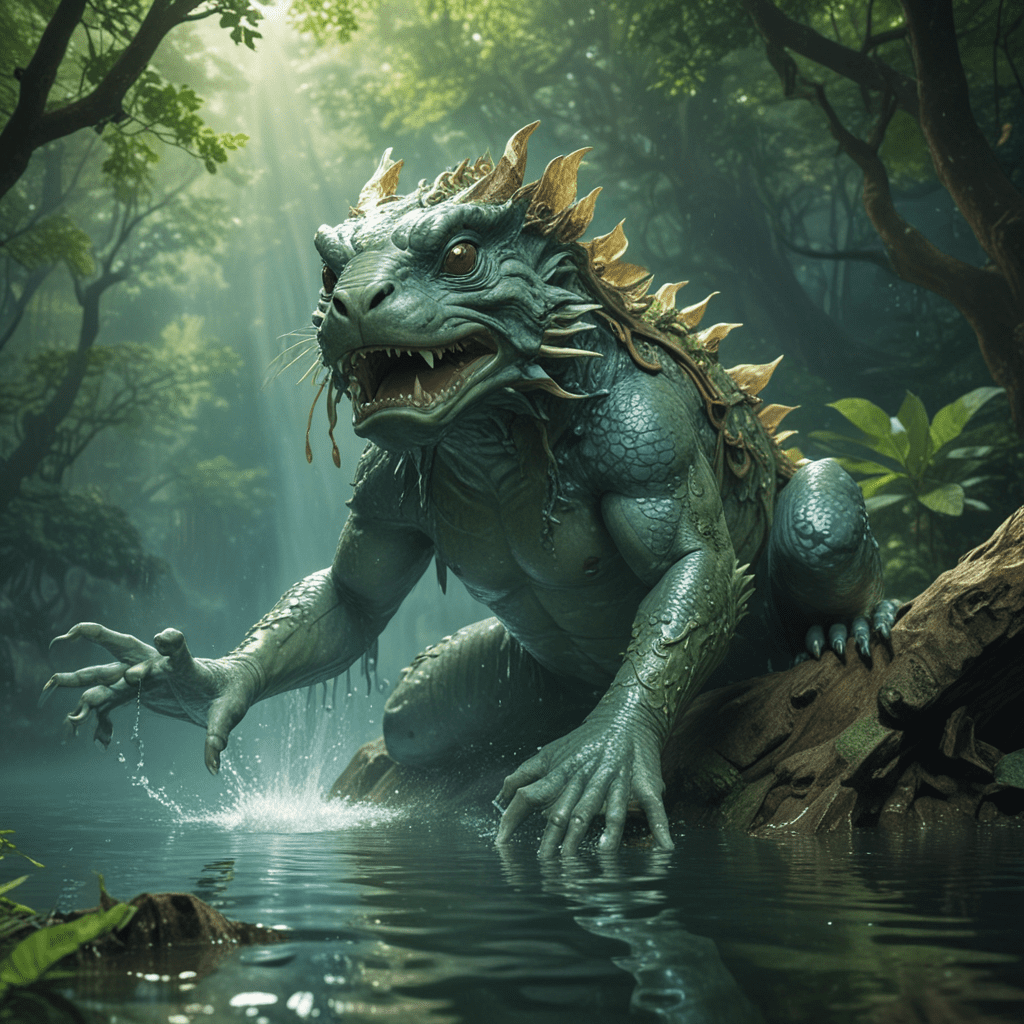The Legend of the Kappa: The Water Imps in Japanese Mythology
Introduction: The Enchanting Realm of Japanese Folklore
Since time immemorial, the enchanting realm of Japanese folklore has captivated imaginations with its mystical creatures and captivating tales. Among these enchanting beings, the kappa holds a prominent place, its enigmatic nature and mischievous antics leaving an indelible mark on Japanese culture and mythology.
The Kappa: Appearance and Etymology of the Water Sprite
The kappa is a mischievous water sprite that inhabits rivers, lakes, and ponds. Its appearance is both comical and frightening. It possesses a humanoid form with a reptilian-like appearance, green skin, webbed feet, and a turtle-like shell on its back. Its most distinctive feature is a plate-like indentation on the top of its head, filled with water. This indentation is considered the kappa's source of power and vitality. The term "kappa" is derived from the Japanese word "kawa-appa," meaning "river child."
Historical Origins: Ancient Legends and Folk Beliefs
The origins of the kappa legend can be traced back to ancient Japanese folklore and folk beliefs. It is believed that the kappa emerged from myths surrounding water spirits and imps. In rural areas, the kappa was often depicted as a mischievous creature that played pranks on unsuspecting humans. It was said to pull people into the water to drown them or steal their possessions.
Habitat and Behavior: From Rivers to Ponds
The kappa is closely associated with water bodies, particularly rivers, lakes, and ponds. It is believed to make its home in deep, secluded areas with abundant vegetation. During the day, the kappa is said to lurk beneath the water's surface, only emerging at night to carry out its mischievous escapades. It is known for its playful and curious nature, often engaging in playful games and interactions with humans.
The Kappa's Affinity for Cucumbers: A Culinary Obsession
One of the most peculiar characteristics of the kappa is its obsession with cucumbers. It is said that the kappa will go to great lengths to obtain cucumbers, even bartering favors or offering rewards. This culinary predilection has earned the kappa the nickname "cucumber boy" in Japanese folklore.
6. Mischievous Pranks or Terrifying Abductions?
The kappa's nature can be both playful and dangerous. It is known for engaging in mischievous pranks, such as playfully pulling people into the water or stealing their belongings. However, it can also be a terrifying creature responsible for drowning victims and abducting children. Fear of the kappa has led to numerous warnings and precautionary tales passed down through generations.
7. The Kappa's Weakness: The Power of Iron
Despite its formidable appearance, the kappa has one significant weakness—iron. In Japanese folklore, iron is believed to possess magical properties that repel evil spirits and protect against supernatural beings. As such, carrying iron objects, such as nails or knives, was considered an effective way to ward off kappa attacks. It is said that even a small piece of iron can cause the kappa immense pain and force it to retreat back into the water.
8. Regional Variations: Diverse Kappa Tales Across Japan
The kappa legend varies significantly across different regions of Japan. In some areas, it is depicted as a benevolent creature that helps lost travelers or even guards against drowning. However, in other regions, it is portrayed as a malevolent entity that poses a threat to humans. These variations reflect the rich diversity of Japanese folklore and the local beliefs and customs associated with the kappa.
9. The Kappa in Modern Culture: Art, Literature, and Entertainment
The kappa has become a prominent figure in modern Japanese culture, appearing in numerous works of art, literature, and entertainment. It has been featured in traditional paintings, woodblock prints, and contemporary sculptures. The kappa has also inspired characters in anime, manga, and video games, contributing to its enduring popularity. Its unique appearance and mischievous nature make it a beloved and recognizable icon of Japanese folklore.
10. Conclusion: The Kappa's Enduring Legacy in Japanese Mythology
The legend of the kappa is a testament to the rich and imaginative nature of Japanese folklore. Through centuries of storytelling and cultural transmission, the kappa has evolved into a complex and captivating creature that continues to fascinate and inspire. Its mischievous antics, playful nature, and connection to Japanese beliefs and traditions have ensured its enduring legacy in Japanese mythology and culture.
Frequently Asked Questions
Q: Is the kappa a real creature?
A: The kappa is a mythical creature in Japanese folklore and has no scientific basis.
Q: Why is the kappa obsessed with cucumbers?
A: The reason for the kappa's affinity for cucumbers is unclear, but it holds a significant place in Japanese folklore and mythology.
Q: How can you protect yourself from kappa attacks?
A: According to folklore, carrying iron objects, such as nails or knives, can ward off kappas.
Q: Are there different types of kappa?
A: Yes, the appearance and characteristics of the kappa can vary across different regions of Japan.
Q: What is the kappa's significance in Japanese culture?
A: The kappa holds cultural significance as a symbol of Japanese folklore and mythology, appearing in various works of art, literature, and entertainment.


